

What's a beach? To us, it's any sandy stretch on the edge of a lake, a river bank, or the ocean. It's a great place for fun and relaxation, and we hasten to add, a great place to take beach photos‚ anytime! While we have summer's warm and sunny weather and long lazy days in mind as we write this, photography on the beach can give great results any time of the year, in any weather, from sunrise to sunset. Here are some beach photo tips that will yield great results, no matter the season.
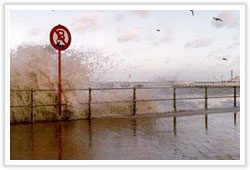
Typically, you won't need lots of fancy gear when you go to the beach. A point-and-shoot or DSLR with a normal range zoom lens is all you'll need. If you wish, bring along a small flash and a tripod for long exposures.
There are two reasons to keep the gear simple when headed to the beach. First and foremost, we're going to have fun, and packing too much equipment just gets in the way. Second, the sand, sun, surf and salty air creates an environment that can be rough on delicate equipment.
Here are some beach photography tips to help you protect the gear that you do bring.
Everyone knows that salt water and surf are rough on cameras. What most people don't realize is that sand can be the worst enemy of all. Fine sand particles can get inside camera bodies and lens barrels and wreak havoc with your camera's mechanics and optics. While camera manufacturers have made great improvements to camera body seals, there are some common sense beach photo tips for you to try.

There are two principal ways that sand can get into your equipment: Wind and stupidity.
Fine particles blown by the wind cannot be avoided, and in those conditions we suggest you work only with "sealed" cameras, anything from a waterproof disposable model, a point-and-shoot or a DSLR that's in a special waterproof housing or a model that's designed for use underwater.
You may wonder about using "waterproof" cameras out of the water, but they are very good for this purpose. The cameras we're talking about are the generally inexpensive "weatherproof" models or "waterproof" models. They're good for use on the beach and, in some cases, on or near the surface of the water. We're not talking about expensive gear designed for deep scuba diving.
(NYIP Director Emeritus Don Sheff, who we note with pride is a Certified Underwater Photographer and veteran diver, reminds us that pressure underwater increases rapidly. Most "waterproof" point-and-shoot cameras can't handle depths greater than 10 or 15 feet. If you want to go deeper, then you'll need either an expensive scuba-housing for your camera, or a specialty scuba camera like the Nikon Nikonos.)
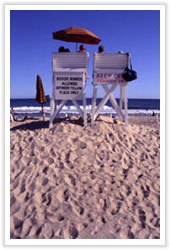
Getting back to the beach, blowing sand is an unavoidable menace, and if you don't have a protected camera, one of the best beach photo tips is to stay away on a windy day. On the other hand, if it's not windy, your regular camera should do if you use it intelligently.
Which brings us to stupidity. Whether it's windy or not, the other way that sand gets into your camera is through carelessness. This includes obvious no-no's like handling the camera with sandy fingers, changing memory cards while your friends are shaking sand out of a blanket, or similar stupidities.
What should you do if, despite your best efforts, some sand does get into your film camera? First, try removing it by using a blower. A rubber bowl blower may suffice. If not, try a compressed air blower. If this doesn't remove all the grains of sand, try Step Two. Gently...GENTLY... use a brush to remove them. A sable or mink brush is best since you don't want to scratch your delicate camera or lens. If brushing doesn't handle the job completely, you're up to Step Three. Even more gently, try to brush away the grains using a microfiber cloth. If you still can't get rid of all the grains of sand, STOP. Bring your camera to a repair shop and let the experts take over.
After sand, heat is the second-most dangerous enemy of your camera when taking beach photos. Heat is hard on cameras and sensitive electronic circuitry. But excess heat is easily avoided. Just keep your equipment out of direct sun. Never let your camera bake in direct sun. Keep it covered and in the shade as much as possible.

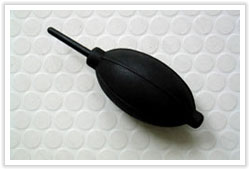
The third gremlin on the beach is humid air. In cold weather, the danger is that the camera gets cold outside so that, when it's brought back into the warm humid air in a house, droplets condense on it. In warm weather, surprisingly, the danger is really just the same. Here's why. Often, your camera is cool because it's been stored in a cool air-conditioned car or a cool air-conditioned cabin on a boat. When that cool camera is brought out into the hot humid air of the beach, it too may have droplets condense on it.
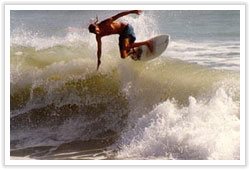
Solution? If your camera is cold, let it adjust to the beach conditions gradually to minimize condensation. In other words, give your digital camera time after you take it out of a cool environment. Never start shooting immediately when you move your camera from a cool-and-dry place to a warm-and-humid place like a beach. Of course, worse than hot, humid air is hot, humid, salty air, the type of air you'll find at an ocean beach in summer. Watch out for salt condensing on your camera ‚ especially on the electronic parts inside your camera. Salt can really damage delicate electronics. What to do? Again, use common sense. If you use a digital camera when taking beach photos, don't open it too often ‚ and shield it from ocean spray when you do. Salt should not get inside. If it does, treat it like sand. Follow these beach photo tips and attempt to blow it out...brush it out...microfiber it out.
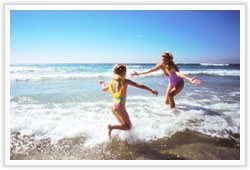
Finally, the most obvious gremlin. Keep water from striking your camera directly. Do everything you can to prevent water from splashing on your camera, or moist air from blowing into the interior of your camera.
What if your camera gets accidentally soaked? If it gets soaked with plain water, let it dry, and take it to a repair shop. But if it falls into salt water and gets thoroughly immersed, contact a repair shop immediately.
A final word about protecting your equipment during beach photography: We've given you all sorts of warnings, but don't get discouraged. If you use ordinary common sense, you won't be bothered by any of these gremlins and you'll be ready to take great shots at the beach.
Now, you may wonder why we included a strobe in our suggested gear. After all, the sunny beach has too much light, if anything. It usually has direct sunlight. That's why many people go to the beach – to sun themselves. Why would we need a strobe to take beach photos? Because of that direct sun, that's why! The bright sun casts dark shadows. We need the strobe to add light to those shadows. To open them up. To fill them. That's the purpose of the strobe. To act as a fill light.


Use fill flash (such as the small built-in flash on your point-and-shoot) to fill in shadows as in these two shots above.
Now that we've covered equipment for beach photography, let's turn to subject matter.
As with all photographs including beach photography, we suggest you keep NYIP's Three Guidelines uppermost in your mind when you shoot.
- Guideline One: What's my subject?
- Guideline Two: How can I give emphasis to my subject?
- Guideline Three: How can I simplify my photograph?
Probably the Number One subject on a beach is people. People at rest. People at play. People swimming. People sunning. People sleeping.
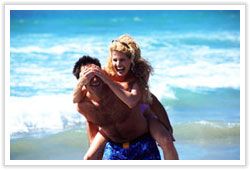

The beach is a powerful backdrop, filled with activity and distraction. To avoid distracting from your subject(s), keep your subject large and up front in your frame. In the NYIP Course we have an entire lesson on techniques for drawing attention to your subject.
When you're photographing people on the beach, the biggest danger is squinting. You follow the old Kodak "rule": You set up with the bright sun streaming into the face of your subject from over your shoulder. Forgetting for the moment the problem this creates with dark shadows (which you open up with your fill flash), we think the biggest problem when taking beach photos is that your subject has to squint. And most people don't look their best when squinting. In fact, most people look terrible squinting. How can you avoid this? One of the most obvious beach photo tips is to try moving your subject into the shade‚for example, the shade of an umbrella. Perhaps, wait till a cloud obscures the direct sun. Or turn your subject so that the sun is behind him or her, and use fill flash to light the face. In other words, watch out for squinting and take steps to avoid it!
In beach scenes of people, the second biggest danger is distraction. Here's where simplification comes in. Pay close attention to the background. It's easy to overlook distracting things when you're surrounded by so many interesting sights. Look carefully. If you see distracting elements‚ — trash cans, coolers, misplaced towels, etc., — try to either remove them or change your angle to eliminate them from view.


This picture of the girl with the sea gulls (above right) is an example of one that could benefit from a little more simplification. We find those two out-of-focus figures sitting at the water's edge are distracting. The photographer might have eliminated them by finding a slightly better angle.
Children at play are among the best subjects for beach photos. Something about the beach seems to promote kids getting lost in fantasy projects. Don't forget to document the results.
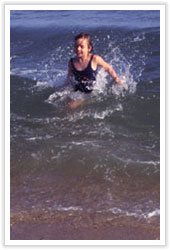
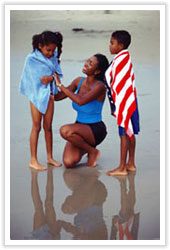
Another common type of beach photo is the scenic shot where you show an entire stretch of beach. It's unusual to get a shot without people so don't even try. In fact, people give a sense of scale to this type of beach photography.
Their activity may even tell a story. Shooting from a high angle may help to capture the sweep of the beach.
Lighting can play a key role in beach photography. We've reminded you in the aforementioned beach photo tips to use fill flash to avoid heavy dark shadows in foreground subjects.
On the other hand, don't rule out using backlighting for dramatic silhouettes including sunset shots.
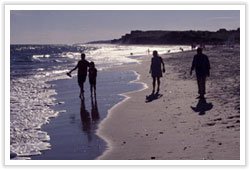
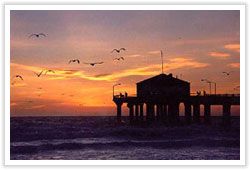
Speaking of sunsets, how do you expose for sunsets? There are a number of possibilities. Best is to take an incident reading of the light or a gray-card reading. Either of these should give you right-on exposure since they read the light regardless of the subject and color. For more information about sunsets, read our article, How to Photograph Sunsets.
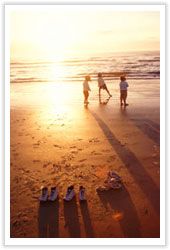
If you don't have an incident light meter or a gray card, then take a reading with your built-in meter...and bracket!
What about with a point-and-shoot that's "automatic everything"? Use the exposure-lock button on your point-and-shoot, and take two readings. First, tip the camera down so it "reads" more dark water and less bright sky in the frame. For beach photos you want to press down the exposure-lock button so the camera is fooled into giving more exposure because it thinks the subject is darker than it really is. Shoot the scene using this exposure reading. Second, tilt the camera up toward the sky and lock exposure on that brighter scene. This time, we've fooled the meter into thinking the scene is brighter than it actually is, so there will be less exposure. Shoot this way. When you get back the prints, pick the photo you like best and tell everyone that's exactly the way it looked.
Remember this above all other beach photo tips: you'll get warmer light and long, dramatic shadows when the sun is low in the sky. Filmmakers call it the "magic hour." But overcast days and open shadows can make interesting photos as well. Let your imagination run wild.


So, now that you've read our beach photography tips, toss your favorite camera into your beach bag, along with your strobe, and get to work on those beach photos. Don't forget the "he-man" subject but watch out for nasty shadows like this one on the right. It's easy to fix, just yell: "Yo, Tarzan, stop straining and lift your fat head and look into the camera!" And get ready to run fast before he has a chance to come over and kick sand in your face.
Enjoy!
Learn more great photography tricks at our online photography school.






